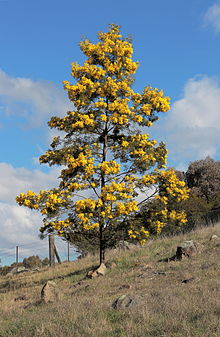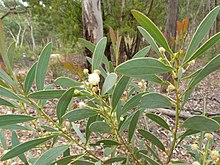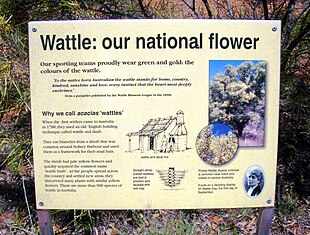Acacia

| Acacia | |
|---|---|
 | |
| Acacia baileyana Canberra | |
| Scientific classification | |
| Kingdom: | Plantae |
| Clade: | Tracheophytes |
| Clade: | Angiosperms |
| Clade: | Eudicots |
| Clade: | Rosids |
| Order: | Fabales |
| Family: | Fabaceae |
| Subfamily: | Caesalpinioideae |
| Clade: | Mimosoid clade |
| Genus: | Acacia Mill.[1] |
| Type species | |
| Acacia penninervis | |
| Species | |
| Synonyms | |



Acacia, commonly known as wattles[3][4] or acacias, is a genus of about 1,084 species of shrubs and trees in the subfamily Mimosoideae of the pea family Fabaceae. Initially, it comprised a group of plant species native to Africa, South America, and Australasia, but is now reserved for species mainly from Australia, with others from New Guinea, Southeast Asia, and the Indian Ocean.[1] The genus name is Neo-Latin, borrowed from the Greek ἀκακία (akakia), a term used in antiquity to describe a preparation extracted from Vachellia nilotica, the original type species.
A number of species of Acacia have been introduced to various parts of the world, and two million hectares of commercial plantations have been established.[5]
Description
[edit]Plants in the genus Acacia are shrubs or trees with bipinnate leaves, the mature leaves sometimes reduced to phyllodes or rarely absent. There are 2 small stipules at the base of the leaf, but sometimes fall off as the leaf matures. The flowers are borne in spikes or cylindrical heads, sometimes singly, in pairs or in racemes in the axils of leaves or phyllodes, sometimes in panicles on the ends of branches. Each spike or cylindrical head has many small golden-yellow to pale creamy-white flowers, each with 4 or 5 sepals and petals, more than 10 stamens, and a thread-like style that is longer than the stamens. The fruit is a variably-shaped pod, sometimes flat or cylindrical, containing seeds with a fleshy aril on the end.[6][7][8][9][10][11]
Taxonomy
[edit]The genus was first validly named in 1754 by Philip Miller in The Gardeners Dictionary.[12] In 1913 Nathaniel Lord Britton and Addison Brown selected Mimosa scorpioides L. (≡ Acacia scorpioides (L.) W.Wight = Acacia nilotica (L.) Delille), a species from Africa, as the lectotype of the name.
History
[edit]Genus Acacia was considered to contain some 1352 species leading to 1986. That year, Leslie Pedley questioned the monophyletic nature of the genus, and proposed a split into three genera: Acacia sensu stricto (161 species), Senegalia (231 species) and Racosperma (960 species), the last name first proposed in 1829 by Carl Friedrich Philipp von Martius as the name of a section in Acacia,[13] but raised to generic rank in 1835.[14][15][16] In 2003, Pedley published a paper with 834 new combinations in Racosperma for species, most of which were formerly placed in Acacia.[17] All but 10 of these species are native to Australasia, where it constitutes the largest plant genus.[10]
In the early 2000s, it had become evident that the genus as it stood was not monophyletic and that several divergent lineages needed to be placed in separate genera. It turned out that one lineage comprising over 900 species mainly native to Australia, New Guinea, and Indonesia was not closely related to the much smaller group of African lineage that contained A. nilotica – the type species. This meant that the Australasian lineage (by far the most prolific in number of species) would need to be renamed. Pedley's proposed name of Racosperma for this group had received little acclaim in the botanical community. Australian botanists proposed a less disruptive solution, setting a different type species for Acacia (A. penninervis) and allowing this largest number of species to remain in Acacia, resulting in the two pan-tropical lineages being renamed Vachellia and Senegalia, and the two endemic American lineages renamed Acaciella and Mariosousa.[18]
In 2003, Anthony Orchard and Bruce Maslin filed a proposal to conserve the name Acacia with a different type, in order to retain the Australasian group of species in the genus Acacia.[16] Following a controversial decision to choose a new type for Acacia in 2005, the Australian component of Acacia s.l. now retains the name Acacia.[19][20] At the 2011 International Botanical Congress held in Melbourne, Australia, the decision to use the name Acacia, rather than the proposed Racosperma for this genus, was upheld.[21][22] Other Acacia s.l. taxa continue to be called Acacia by those who choose to consider the entire group as one genus.[22]
The Australian species of the genus Paraserianthes s.l. (namely P. lophantha) are deemed its closest relatives.[23] The nearest relatives of Acacia and Paraserianthes s.l. in turn include the Australian and South East Asian genera Archidendron, Archidendropsis, Pararchidendron and Wallaceodendron, all of the tribe Ingeae.[24]
Etymology
[edit]The genus name is Neo-Latin, borrowed from the Greek akakia, a name used by Dioscorides for some prickly species growing in Egypt, from acacis meaning "a point".[25] In his Pinax (1623), Bauhin mentioned the Greek ἀκακία from Dioscorides as the origin of the Latin name.[26]
The origin of "wattle" may be an Old Teutonic word meaning "to weave".[27] From around 700 AD, watul was used in Old English to refer to the flexible woody vines, branches, and sticks which were interwoven to form walls, roofs, and fences. Since about 1810 it has been used as the common name for the Australian legume trees and shrubs that can provide these branches.[27]
Species
[edit]There are about 1,080 species of Acacia, mostly native to Australia.[9]
Fossil record
[edit]An Acacia-like 14 cm (5.5 in) long fossil seed pod has been described from the Eocene of the Paris Basin.[28] Acacia-like fossil pods under the name Leguminocarpon are known from late Oligocene deposits at different sites in Hungary. Seed pod fossils of †Acacia parschlugiana and †Acacia cyclosperma are known from Tertiary deposits in Switzerland.[29] †Acacia colchica has been described from the Miocene of West Georgia. Pliocene fossil pollen of an Acacia sp. has been described from West Georgia (including Abkhazia).[30] The oldest fossil Acacia pollen in Australia are recorded as being from the late Oligocene epoch, 25 million years ago.[31]
Distribution and habitat
[edit]Species of Acacia occurs in all Australian states and territories, and on its nearby islands. About 20 species occur naturally outside Australia and 7 of these also occur in Australia. One species (Acacia koa) is native to Hawaii[32] and one (Acacia heterophylla) is native to Mauritius and Réunion in the Indian Ocean.[9][33]
They are present in all terrestrial habitats, including alpine settings, rainforests, woodlands, grasslands, coastal dunes and deserts.[11] In drier woodlands or forests they are an important component of the understory. Elsewhere they may be dominant, as in the Brigalow Belt, Myall woodlands and the eremaean Mulga woodlands.[11]
In Australia, Acacia forest is the second most common forest type after eucalypt forest, covering 980,000 square kilometres (378,380 sq mi) or 8% of total forest area. Acacia is also the nation's largest genus of flowering plants with almost 1000 species found.[34]
Ecology
[edit]Acacia is a common food source and host plant for butterflies of the genus Jalmenus. The imperial hairstreak, Jalmenus evagoras, feeds on at least 25 acacia species.[35] Many reptiles feed on the sap, such as the native house gecko in Australia.[36] The sap is also consumed by bugs (Hemiptera), such as Hackerobrachys viridiventris[37] and Sextius virescens.[38]
Toxicity
[edit]Some species of acacia contain psychoactive alkaloids, and some contain potassium fluoroacetate.[39]
Uses
[edit]
The seed pods, flowers, and young leaves are generally edible either raw or cooked.[40]
Aboriginal Australians have traditionally harvested the seeds of some species, to be ground into flour and eaten as a paste or baked into a cake. Wattleseeds contain as much as 25% more protein than common cereals, and they store well for long periods due to the hard seed coats.[41] In addition to using the edible seed and gum, the people employed the timber for implements, weapons, fuel and musical instruments.[11] A number of species, most notably Acacia mangium (hickory wattle), A. mearnsii (black wattle) and A. saligna (coojong), are economically important and are widely planted globally for wood products, tannin, firewood and fodder.[19] A. melanoxylon (blackwood) and A. aneura (mulga) supply some of the most attractive timbers in the genus. Black wattle bark supported the tanning industries of several countries, and may supply tannins for production of waterproof adhesives.[11]
In Vietnam, Acacia is used in plantations of non-native species that are regularly clear-cut for paper or timber uses.[42][43]
Wattle bark collected in Australia in the 19th century was exported to Europe where it was used in the tanning process. One ton of wattle or mimosa bark contained about 68 kilograms (150 pounds) of pure tannin.[44]
The gum of some species may be used as a substitute for gum arabic, known as Australian gum or wattle gum.[45]
Cultivation
[edit]Some species of acacia – notably Acacia baileyana, A. dealbata and A. pravissima – are cultivated as ornamental garden plants. The 1889 publication Useful Native Plants of Australia describes various uses for eating.[46]
References
[edit]- ^ a b c "Acacia". Plants of the World Online. Kew Science. Royal Botanic Gardens, Kew. Retrieved 9 December 2023.
- ^ "Report of the General Committee". Taxon. 55 (3): 798. 2006. doi:10.2307/25065657.
- ^ "Entry: wattle". The American Heritage Dictionary. 2022. Retrieved 2024-10-10.
- ^ "Wattle". Collins English Dictionary. Retrieved 2024-10-10.
- ^ Midgley, S.J.; Turnbull, J.W. (2003). "Domestication and use of Australian acacias: Case studies of five important species". Australian Systematic Botany. 16 (1): 89–102. doi:10.1071/SB01038.
- ^ Kodela, Phillip G.; Harden, Gwen J. "Genus Acacia". Sydney, NSW, AU: Royal Botanic Garden. Retrieved 9 December 2023.
- ^ Entwisle, Timothy J.; Maslin, Bruce R.; Cowan, Richard S.; Court, Arthur B.; Walsh, Neville G. "Acacia". Melbourne, VIC, AU: Royal Botanic Gardens Victoria. Retrieved 9 December 2023.
- ^ "Acacia". Adelaide, SA, AU: State Herbarium of South Australia. Retrieved 9 December 2023.
- ^ a b c Kodela, Phillip G.; Maslin, Bruce R. (n.d.). Kodela, Philip G. (ed.). "Acacia". Australian Biological Resources Study. Flora of Australia. Canberra, AU: Department of Climate Change, Energy, the Environment, and Water. Retrieved 9 December 2023.
- ^ a b Murphy, Daniel J. (2008). "A review of the classification of Acacia (Leguminosae, Mimosoideae)" (PDF). Muelleria. 26 (1): 10–26. Retrieved 20 July 2024.
- ^ a b c d e Orchard, Anthony E.; Wilson, Annette J.G. (2001). Flora of Australia. Vol. 11A, Mimosaceae, Acacia. Melbourne, VIC, AU: CSIRO. part 1, page x. ISBN 9780643067172.
- ^ Miller, P. (1754). The Gardeners Dictionary. Vol. 1 (abridged, 4th ed.). p. 25. — only gives the name of the genus. Miller did not validly publish names of species in this book, as he did not consistently use binomial names.
- ^ von Martius, Carl Friedrich P. (1829). Hortus regius Monacensis. p. 188.
- ^ von Martius, C.F.P. (1835). Hortus regius Monacensis seminifer. p. 4. Archived from the original on 2022-01-10. Retrieved 2020-06-19.
- ^ Pedley, L. (1986). "Derivation and dispersal of Acacia (Leguminosae), with particular reference to Australia, and the recognition of Senegalia and Racosperma". Botanical Journal of the Linnean Society. 92 (3): 219–254. doi:10.1111/j.1095-8339.1986.tb01429.x. PMC 7188348. PMID 32362685.
- ^ a b Orchard, A.E.; Maslin, B.R. (2003). "Proposal to conserve the name Acacia (Leguminosae: Mimosoideae) with a conserved type". Taxon. 52: 362–363. doi:10.2307/3647418. JSTOR 3647418.
- ^ Pedley, L. (2003). "A synopsis of Racosperma (C. Mart.) (Leguminosae: Mimosoideae)". Austrobaileya. 6 (3): 445–496. doi:10.5962/p.299681. JSTOR 41738994.
- ^ Kyalangalilwa, B.; Boatwright, J.S.; Daru, B.H.; Maurin, O.; van der Bank, M. (2013). "Phylogenetic position and revised classification of Acacia s.l. (Fabaceae: Mimosoideae) in Africa, including new combinations in Vachellia and Senegalia". Botanical Journal of the Linnean Society. 172 (4): 500–523. doi:10.1111/boj.12047. hdl:10566/3454.
- ^ a b Thiele, Kevin R. (February 2011). "The controversy over the retypification of Acacia (Mill.) with an Australian type: A pragmatic view" (PDF). Taxon. 60 (1): 194–198. doi:10.1002/tax.601017. Retrieved 15 November 2015.
- ^ Brummitt, R.K. (December 2010). "(292) Acacia: A solution that should be acceptable to everybody" (PDF). Taxon. 59 (6): 1925–1926. doi:10.1002/tax.596050. Retrieved 19 November 2015.
- ^ The Acacia debate (PDF) (Report). IBC2011 Congress News. Retrieved 5 May 2016.
- ^ a b Smith, Gideon F. & Figueiredo, Estrela (2011). "Conserving Acacia (Mill.) with a conserved type: What happened in Melbourne?". Taxon. 60 (5): 1504–1506. doi:10.1002/tax.605033. hdl:2263/17733.
- ^ Brown, Gillian K.; Daniel J. Murphy & Pauline Y. Ladiges (2011). "Relationships of the Australo-Malesian genus Paraserianthes (Mimosoideae: Leguminosae) identifies the sister group of Acacia sensu stricto and two biogeographical tracks". Cladistics. 27 (4): 380–390. doi:10.1111/j.1096-0031.2011.00349.x. PMID 34875795. S2CID 85416700.
- ^ Brown, Gillian K.; Murphy, Daniel J.; Miller, Joseph T.; Ladiges, Pauline Y. (October 2008). "Acacia s.s. and its relationship among tropical legumes, tribe Ingeae (Leguminosae: Mimosoideae)". Systematic Botany. 33 (4): 739–751. doi:10.1600/036364408786500136. S2CID 85910836.
- ^ Sharr, Francis Aubi; George, Alex (2019). Western Australian Plant Names and Their Meanings (3rd ed.). Kardinya, WA: Four Gables Press. p. 56. ISBN 9780958034180.
- ^ Bauhin, Caspar (1623). Pinax theatri botanici Caspari Bauhini. Basileae Helvet. p. 391.
- ^ a b Austin, Daniel F. (2004). Florida Ethnobotany. Boca Raton, FL: CRC Press. p. 58. ISBN 9780203491881.
- ^ Kenrick, Paul; Davis, Paul (2004). Fossil Plants. London, UK: Natural History Museum. ISBN 0-565-09176-X.
- ^ Hably, L. (1992). Herendeen, P.S.; Dilcher (eds.). Distribution of Legumes in the Tertiary of Hungary. Advances in Legume Systematics. Vol. Part 4, The fossil record. London, UK: Royal Botanic Gardens, Kew. ISBN 0947643400.
- ^ Shakryl, Alexandra K. (1992). Herendeen, P.S.; Dilcher (eds.). Leguminosae species from the territory of Abkhazia. Advances in Legume Systematics. Vol. Part 4, The fossil record. London, UK: Royal Botanic Gardens, Kew. ISBN 0947643400.
- ^ White, M.E. (1988). The Greening of Gondwanana (reprint ed.). Australia: Reed Books. ISBN 0730101541.
- ^ "Acacia koa". Plants of the World online (powo.science.kew.org). Kew Science. London, UK: Royal Botanic Gardens, Kew. Retrieved 10 December 2023.
- ^ "Acacia heterophylla". Plants of the World online (powo.science.kew.org). Kew Science. London, UK: Royal Botanic Gardens, Kew. Retrieved 10 December 2023.
- ^ "Acacia forest". agriculture.gov.au. Department of Agriculture. Commonwealth of Australia. 6 February 2017. Retrieved 19 April 2017.
- ^ Kitching, Roger Laurence (1999). Biology of Australian Butterflies. Collingwood, VIC, AU: CSIRO Pub. ISBN 978-0643050273. OCLC 40792921.
- ^ Alamy Limited (agency). Flat-headed house gecko (Hemidactylus platycephalus) adult feeding on solidified sap of acacia tree. Kafue N.P. Zambia (stock photo). Retrieved 2022-03-25 – via alamy.com.
- ^ Constant, J. (2006). "Revision of the Eurybrachidae (VII). The Australian genera Hackerobrachys and Fletcherobrachys (Hemiptera: Fulgoromorpha: Eurybrachidae)". Bulletin de l'Institut Royal des Sciences Naturelles de Belgique, Entomologie. 76: 31–40 – via researchgate.net.
- ^ "Acacia horned treehopper – Sextius virescens". brisbaneinsects.com. Retrieved 2023-02-12.
- ^ Leong, L.E.; Khan, S.; Davis, C.K.; Denman, S.E.; McSweeney, C.S. (2017). "Fluoroacetate in plants – a review of its distribution, toxicity to livestock and microbial detoxification". Journal of Animal Science and Biotechnology. 8: 55. doi:10.1186/s40104-017-0180-6. PMC 5485738. PMID 28674607.
- ^ The Complete Guide to Edible Wild Plants. United States Department of the Army (original publisher) (reprint ed.). New York, NY: Skyhorse Publishing. 2009. p. 16. ISBN 978-1-60239-692-0. OCLC 277203364.
{{cite book}}: CS1 maint: others (link) - ^ Tan, Ria. "Acacia auriculiformis, black wattle". Naturia. Archived from the original on 5 May 2015. Retrieved 17 November 2015.
- ^ Nambiar, E.K. Sadanandan; Harwood, Christopher E.; Kien, Nguyen Duc (2015). "Acacia plantations in Vietnam: Research and knowledge application to secure a sustainable future". Southern Forests. Sustaining the future of acacia plantation forestry. 77 (1): 1–10. Bibcode:2015SFJFS..77....1N. doi:10.2989/20702620.2014.999301. S2CID 84167231.
- ^ Tatarski, Michael (20 May 2021). "Drastic forest development: Vietnam to plant 1 billion trees – but how?". Mongabay Environmental News. Retrieved 5 November 2023.
- ^ Knight, Charles, ed. (1847). The National Cyclopaedia of Useful Knowledge. Vol. II. London, UK. p. 873.
- ^ King, J.; Felter, H.W.; Lloyd, J.U. (1898). "Acacia (U. S. P.)—Acacia". King's American Dispensatory (18th ed.). Cincinnati: Ohio Valley Company. p. 9.
- ^ Maiden, J.H. (1889). Useful Native Plants of Australia, including Tasmania. Sydney, AU: Turner & Henderson.
External links
[edit]- Acacias of Australia (Lucid web player). WATTLE. — multi-access key for identifying Australian Acacias